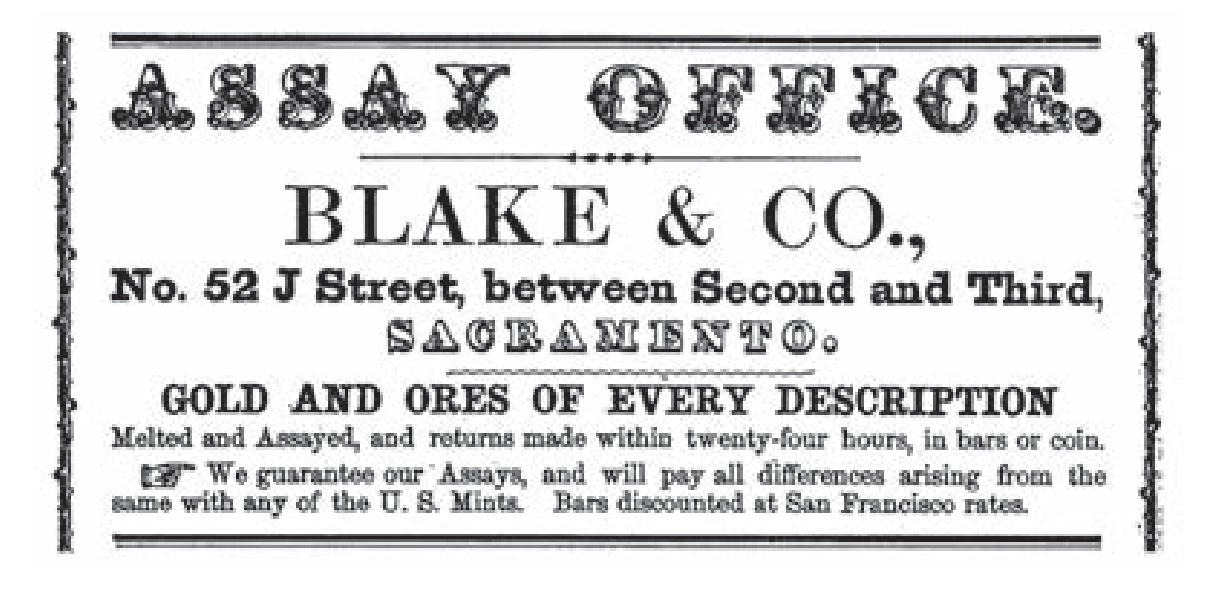The following information on F.W. Blake is taken from Stack’s catalog for Part XXI of the John J. Ford, J. Collection, October 2007, which in turn is attributed to A Historical Description and Commercial Directory of Owyhee County, Idaho (January 1898, Silver City Idaho), p. 101: Owyhee Avalanche (1898). Blake, Mr. F.W., was born in Boston, July 24, 1828. He went to California in 1852, settling in Weaverville, and engaging in the assaying business, and subsequently moved to Unionville, Nevada, where he opened an assay office, and was married to Miss Sarah Meador, of that place. In 1866 he came to Silver City, and was engaged as assayer for all the principal mines and mills in this locality.
He erected the granite block on Washington Street, now occupied by Dave Adams, and took a very active interest in the affairs of the county generally. In 1873 he left with his family for New York, remaining there until 1875, when he returned to the west, locating at Prescott, Arizona, where he engaged in banking and assaying, and also as agent for Wells, Fargo & Company’s express, and served one term as mayor of Prescott. His death occurred August 2, 1895, at Prescott, Arizona, and his widow and only son (a native of Silver City) still reside at Prescott, where his son carries on his father’s business.
Blake Story, By Fred N. Holabird
The Blake Cousins From Boston
Blake came to California with his cousin Gorham Blake in 1852 on board the steamer Constitution. The pair were the same age, born and raised in Boston. Gorham’s father died in 1847 when Gorham was 18. The family fortune was left to his sister [Suffolk County PR 37379, 149:70]. Both Gorham and Francis (Frank) Blake probably became acquainted with Johan Agrell in Boston, a young goldsmith from Sweden about the same age. Agrell came to California at the same time, and may have even come with the cousins. When they landed, however, the group split up. Frank went to Weaverville, an important mining camp in the central Trinity Mountains along the Trinity River, and Gorham and Johan went to Placerville. The group would follow very parallel lines of work until they met up again in 1860.
FW Blake Enters the Express Business
Blake immediately went to work for Rhodes & Lusk in Weaverville as an express agent [History of Northern California, p276 Lewis Publishing, 1891. Much of this is repeated in Cross, and may have been Cross’ source]. Rhodes & Lusk were the most prominent express firm in the entire Trinity-Shasta gold regions, and by November of 1852 were the primary banking house as well. The region, and Shasta in particular, was so important that Shasta made a play for the California State Capital just before it was firmly established in Sacramento. The
Rhodes & Lusk experience introduced Frank into the gold business in a big way. The business was processing $15,000 per week in gold. The year Blake got there was notable, since Weaverville was home at the time to James W. Denver, the future namesake of Denver, Colorado, and participant in the Colorado gold rush. Denver and California governor John Bigler managed a relief train for emigrants, and after the pair were accused of skullduggery by the Alta Californian, Denver challenged the editor (Gilbert) to a duel. Gilbert was killed . . . Denver was appointed Secretary of State by Bigler, then elected to Congress in 1854.
That same year in 1854, a terrible uprising took place in Weaverville between whites and Chinese miners, with numerous deaths on both sides.
The Rhodes & Lusk business was connected to Wells Fargo by contract, and their competitor, Cram Rogers & Co., were connected with Adams Express. Rhodes & Co. changed partners a number of times until the firm ultimately “retired” in 1857[Cross, Financing an Empire. 1927. Also Winther, O.; Via Western Express Stagecoach; 1945, p. 51-2]. Blake may have purchased the business, because in 1857 he was listed as the senior partner in the F. W. Blake & Co. Express [Wiltsee, E.; The Pioneer Miner and Pack Mule Express, 1931 (1976 edition), p. 103]. Blake continued to run this firm for at least another year.
There is disagreement between historians when Blake opened his own Express company in Weaverville. McDonald claimed it was 1852, and Owens said it was at least 1854 [See Owens, D.; California Coiners and Assayers, 2000, p. 102]. Wiltsee says 1857. Regardless, Blake kept the Wells Fargo agent designation with whatever company he was with. He remained in business in Weaverville until 1859 [McDonald, Doug; in Rare Coin Review, Spring 1987 and others (FH manuscript); Owens, D.; California Coiners and Assayers; 2000].
Gorham Blake after Placerville
Gorham Blake, meanwhile, left Placerville and joined with William Waters. He had been an agent for Adams & Co.’s Express and other businesses. Blake got to know W. C. Waters, son of William Waters a Sacramento businessman.
In 1855 Blake opened an assay office with John Agrell in Sacramento in November. They hired David Lundbom who had worked for the USAO in San Francisco and also for Kellogg & Co. But the partnership only lasted a month until the year’s end. Blake started his assay office just one month after Harris & Marchand started theirs. In 1856 they noted that the poorest quality gold dust was “coming from Carson Valley” worth only $12.13 per oz. At that time the business was known as Blake & Co. The senior Waters, William Waters, became a partner within the year, and the partnership would last for many years to come.
Blake was not listed in the residential section of the Sacramento Directory in 1858. He may have returned briefly to Boston, or ventured into the mining region near Sacramento looking for a mining investment.
In late 1859, Frank Blake moved to Sacramento to join his cousin. From there the pair moved quickly to Grass Valley, and were both there when the 1860 Census was taken in June. Here they heard the news of the great Comstock discoveries, but were deeply involved in their own mine. Meanwhile, Waters, four years older, was running the Sacramento assay office under the name Waters & Co, and Gorham was this time the minor partner. That partnership formerly ended April, 1861. Gorham went back to Boston immediately. About this time he began a letter correspondence with his cousin Louisa. He even tried to talk her into sending west her husband, who opted to stay in Boston [The letters are at the Bancroft Library. See Owens].
The Blakes Strike Silver in Nevada
Frank moved to Carson City in 1861 after the Nevada County mining fray, where he may have contemplated opening an assay office, or perhaps worked for Harvey Harris [FW Blake is listed in Carson City in the 1862 Territorial Census. No occupation]. David Lundbom, the assayer who worked for Gorham in Placerville, went to work for Harris when he opened his Carson City assay office in 1861 and later the Gold Hill office in 1862. Harris used the name “Pioneer Assay Office” in both Carson City and Silver City, a phrase he used to his advantage in Marysville as well [10/20/1861 Carson City Silver Age].
In Carson, Frank Blake at one time worked for J. O. Pope. He was a member of the Odd Fellows, and might have met up with Sam Clemens, who was a Mason. They were all about the same age, and in the early winter of 1861, the Clemens brothers were off to Unionville to seek their fortune [Much is written by Sam Clemens of their Unionville forays. See Roughing It]. Blake either followed about that time, or went the next summer when his cousin Gorham returned to California, first to Placerville, then to Carson City the first week in June. In a letter to Louisa in June, he said he had sent for his assaying tools, so he clearly envisioned opening an assay office somewhere.
Unionville, the Land of Silver
During 1862, the pair left Carson City on June 9th, and arrived in Unionville several days later. Long letters from Gorham to Louisa explain the intense and long exploration of the mines in the Humboldt region[See Owens, California Coiners and Assayers]. The cousins were obviously looking to buy a mine. Gorham notes in the letters that he expects to return to Sacramento to see Mr. Waters, perhaps to continue their assay business.
The Blake cousins had such a good time in Unionville, well described in several letters to Louisa in Massachusetts, that Frank may never have returned to Carson City except to get his things. Gorham probably did not either. By 1863, F. W. Blake was running his own assay office, probably with Gorham as a partner, and the pair were no doubt buying and selling feet in mines just like the rest of the crowd who specialized in mining. Indeed, in May, 1863, Frank Blake reported to the Humboldt Register that the discovery of the Miami ledge in the Sierra District by Ferguson & Wilson yielded $1340.86 per ton, and another $4786.74, according to an assay certificate issued by F W. Blake, assayer [Humboldt Register, May 23, 1863]. The Blakes did not advertise in the Humboldt papers until much later, probably because the market was so small that everybody knew them anyway. F. W. Blake also acted as a mining secretary, a potentially lucrative job, since it was customary to pay corporate secretaries in stock. Advertisements in the 1863 Humboldt mining region newspapers included companies such as Manitowoc G&S MC, Humboldt Salt Mining Co. Blake was the secretary for both companies and others [See also McDonald]. The Blake cousins may have been among the original incorporators of the Manitowoc, which was organized in May 1863.
The Unionville Discovery History
The mines at Unionville were discovered on May 15, 1861. The first locators were William J. Whitney, Hugo Pfersdorff and J. C. Hannan. A small rush ensued. The first miner’s meeting was eight days later. Pfersdorff and Hannan had come to the country in the company of a few local Indians. It was first recorded thus in the Humboldt Register: “On the twelfth day of May, 1861, just as the sun was sinking behind the Sierra, two men, a couple of donkeys, and four native Paiutes, reached the summit of the mountain that overlooks the present town of Unionville. Until that time it is supposed that no white man had ever visited, or even seen, Buena Vista Canyon,” which they named on the spot because of the view [5/16/1863 Humboldt Register, p1, column 3].
The Aftermath. Silver City, Idaho
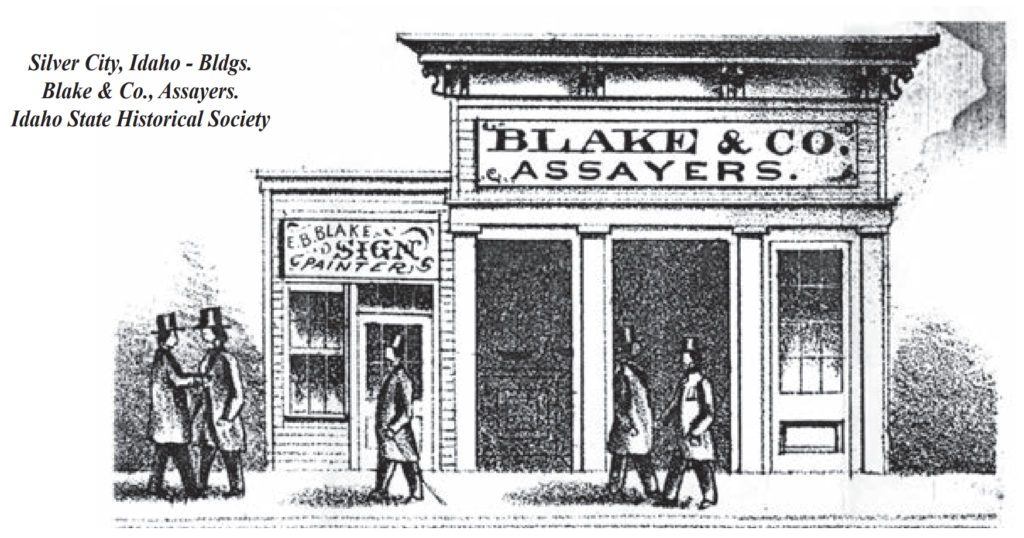
Gorham Blake disappeared from the western mining scene, possibly returning to Boston. F. W. Blake remained in Unionville until 1866. As a former owner of an express company, Blake undoubtedly noticed the traffic between Unionville and the new gold camps of the Boise Basin in Idaho. Just after their discovery, silver was found at a new site known as Silver City in southern Idaho. With business slowly dwindling in Unionville, Blake took up his tools, business and goods and was off to Silver City, where he immediately set up an assay office.
In Silver City, the business was an immediate hit. He soon earned the business of most of the mines, and as a friendly family man with a new son, the family was well liked. He had a few competitors, but in the end, Blake was the most experienced assayer, and as such was likely to receive the bulk of the business.
In 1869, Blake took a foray into Golconda, Nevada while continuing to run his assay office in Silver City [From the F. W. Blake Correspondence, Golconda, Nevada and Silver City, Idaho, c 1867-1870]. The Golconda business lasted less than a year, and he returned to Silver City, where he continued to build his business empire with the acquisition of a jewelry store and other real estate.
Back To Boston
In 1873 Blake and his family left for Boston, ostensibly to visit his ailing mother, but, they remained there for some time. Gorham also returned home about the same time too. In 1875 they again travelled west to the gold camp of Prescott, where he was appointed an express agent for the Arizona and New Mexico Express. Within a few months he opened his own assay office as well, and quickly secured some of the assaying work needed by the Peck Mining Company, for which there is only one ingot known today. When Wells Fargo opened their office, Blake was appointed agent, and no doubt had some say in getting Wells Fargo to bring their business to Prescott anyway. Blake was so popular that he was elected Mayor. He remained there for the rest of his life, working at various management jobs from dawn to dusk.
Gorham, meanwhile, went to Georgia to investigate gold mines there. He looked at properties in Lumpkin County around Dahlonega and Auraria without success. He found good placer ground in White County just a couple of miles outside of the County Seat, and bought a huge parcel, which he worked for a few years.
There are only two (2) Unionville ingots known and eight (8) Owyhee. Unionville ingots are from an earlier period and 4x more rare – they were can be traced to a small window of two years between 1864-1866. There is also one (1) additional Owyhee ingot known but it was stolen in 2007, likely never to surface again.
Unionville, Nevada Ingots
4.15 oz Blake & Company. Upper Unionville, Humboldt County, Nevada Territory. $3.88 Value, .724 Fine, Silver assay ingot no. 319.
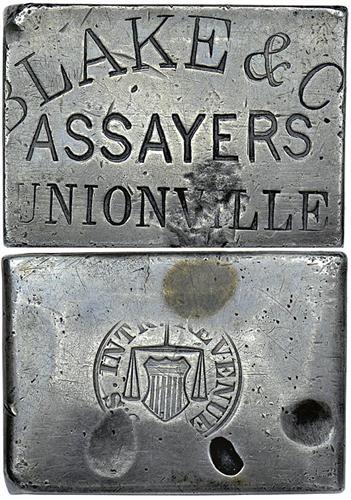
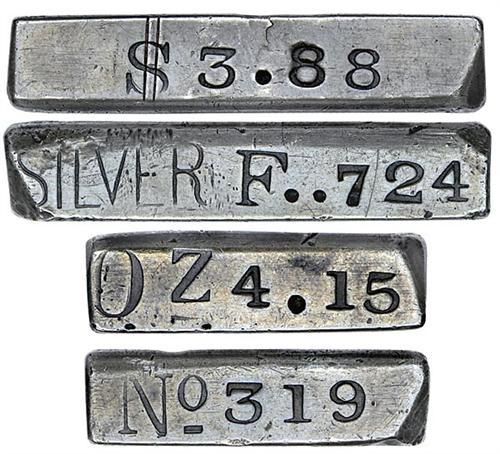
Overall appearance of Extremely Fine/Fine. A nice looking bar, square in shape, flat top and slightly rounded back. Smaller on the top than the logotypes used, some letters run off the edges. Flawed on both sides, the back particularly. Opposing corners clipped like the bigger S.S. Central America gold bars. Extremely rare: Blake was in Humboldt County less than two years; this and the next are the only Blake bars in Mr. Ford’s collection with this address. The bar can be dated, consequently, to the period September 1, 1864 to April 30, 1866. The cataloguer can recall only one other Blake ingot from this address, ingot no. 372.
- Face: BLAKE & C[o.] / ASSAYERS. / UNIONVILLE [HUMBOLDT – CO.N.T.].
- Back: OIR stamp.
- Top side: SILVER F..724.
- Bottom side: $3.88.
- Left side: NO.319.
- Right side: Oz 4.15.
- Dimensions: 44.1 x 31.4 x 9.7 mm.
- Current weight: 129.3 gms.
From the John J. Ford, Jr. Collection
Provenance: Provenance unrecorded.
[10/2007] https://auctions.stacksbowers.com/lots/view/3-AV6KJ/blake-company-upper-unionville-humboldt-county-nevada-territory-silver-assay-ingot-no-319 ($20,700)
31.6 mm x 44.2 mm x 9.7 mm. Northwest corner of top face and southwest corner of base truncated for additional assay. Top face stamped “Blake & C. / Assayers” with one prepared punch, UNIONVILLE below in another. Base shows IRS revenue stamp, used only 1863-1867. Serial number on left face, No. 319, weight stamped on right face, silver fineness on north face, value $3.88 on south face. Even, deep silver gray tone on smooth, attractive surfaces. Some natural roughness, as made, at VIL of UNIONVILLE. Three depressions on base below and beside revenue stamp, which remains bold at center and nearly complete at periphery. Only minor evidence of handling. This attractive and readily datable ingot was produced before Gorham Blake, best known as the Blake who produced 34 of the ingots found on the 1857 wreck of the S.S. Central America, left the business about 1866. It is no coincidence that this ingot resembles those so closely. Needless to say, the ingots produced by cousins Gorham and Francis W. Blake in Unionville, Nevada Territory are far rarer than the related ingots from the S.S.Central America. The Unionville Blake ingots were issued in perhaps the ultimate Western mining setting—the mining camp (and, now, ghost town) that inspired Mark Twain’s Roughing It, and as such represent an ideal tangible manifestation of the Old West.
Provenance: From StacksBowers sale of the John J. Ford, Jr. Collection, Part XXI, October 2007, Lot 3504.
[07/2009] https://auctions.stacksbowers.com/lots/view/3-B2LGO/nevada-territory-blake-and-co-assayers-unionville-415-ounces-724-fine-silver ($20,700)
15.02 oz Blake & Company. Upper Unionville, Humboldt County, Nevada Territory. Silver assay ingot no. 147.
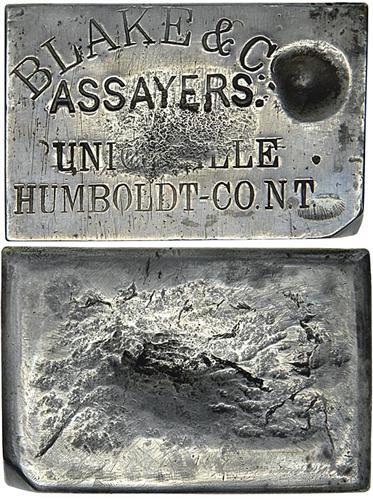
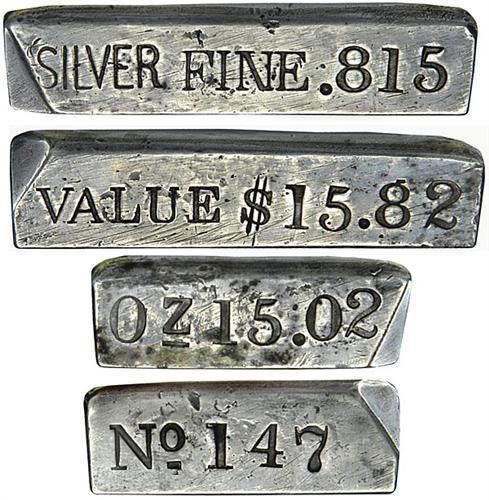
Overall appearance of Very Fine. A bigger bar than the last, medium gray color, nicely squared off edges. Deep flaw at right on the face, cooling fissure on back. Two opposing corners clipped. Made before the previous but listed here by its size and weight. Extremely rare as the last. The bar may be dated to the period April/May, 1864 to September 1 or slightly later, 1864.
- Face: BLAKE & Co. / ASSAYERS. / UNIONVILLE / HUMBOLDT – CO.N.T.
- Back: Blank.
- Top side: VALUE $15.82.
- Bottom side: SILVER FINE .815.
- Left side: No.147.
- Right side: Oz. 15.02.
- Dimensions: 66.6 x 44.5 x 16.4 mm.
- Stated weight: 15.02 ozs.
From the John J. Ford, Jr. Collection
Provenance: Provenance unrecorded.
[10/2007] https://auctions.stacksbowers.com/lots/view/3-AV6KP/blake-company-upper-unionville-humboldt-county-nevada-territory-silver-assay-ingot-no-147 ($29,900)
Owyhee, I.T. Ingots
6.85 oz Blake & Co Owyhee County, Idaho Territory, No 1173
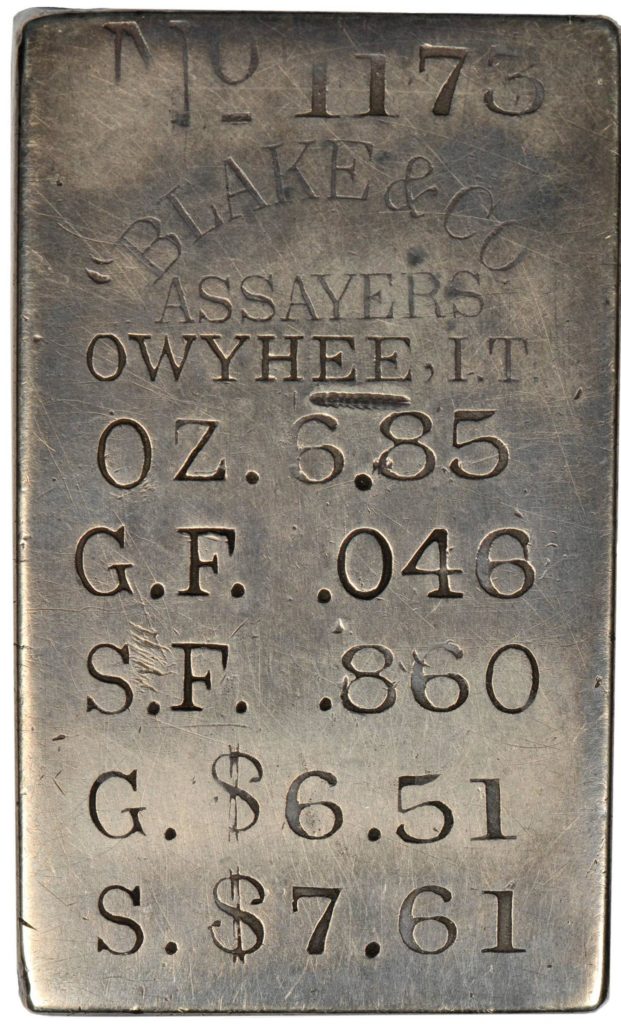
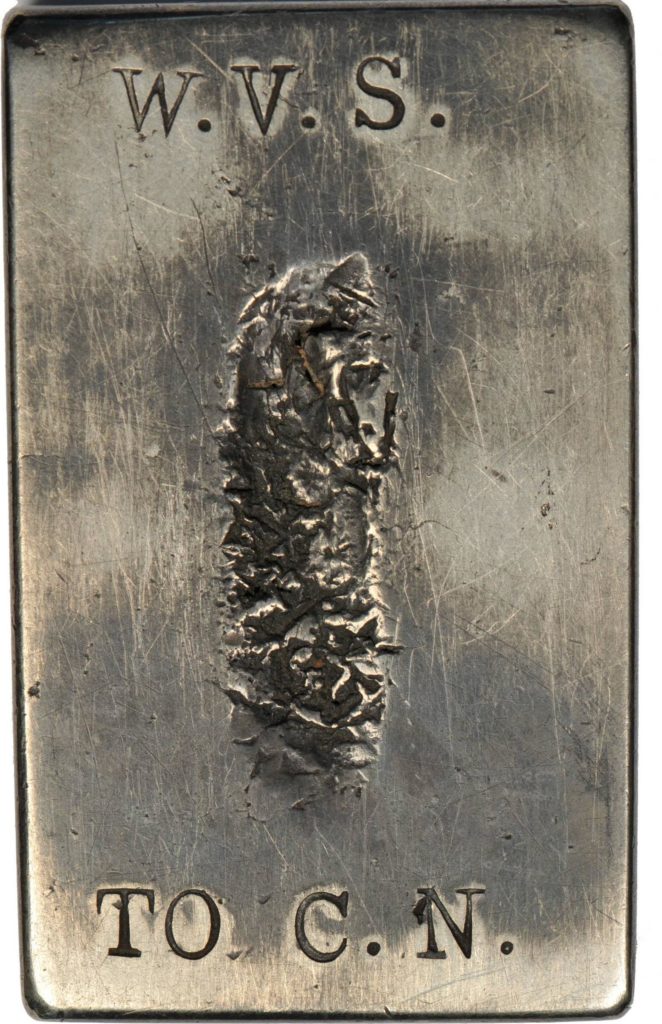
Nicely Made and Appealing Blake & Co. Mixed Metal Presentation Ingot, Stamped Circa 1870 in Silver City, Owyhee County, Idaho Territory, Mixed Metal Presentation Ingot. No. 1173. 6.85 Ounces.
The edges are squared off and crisp, indicating that this bar was carefully prepared for presentation purposes, as further indicated by the back inscription W.V.S. / TO C.N. The bar also appears to have been polished before stamping.
All sides are lightly and evenly toned in a pewter-gray patina with mostly light handling marks that are hardly worth mentioning. A mark is evident on the face below the letters EE in OWYHEE, and a production flaw is centered on the back.
This bar has the same general layout as the Blake & Co. Owyhee County mixed metal presentation ingots from the Ford Collection that appeared at auction in October 2007. The placement of all pertinent information on the face of the ingot, combined with the obvious care with which these pieces were prepared, establish this family of ingots as among the best produced by any Western assayer. Significantly, Blake’s ingots from Silver City are superior in workmanship and quality to his earlier ingots produced in Unionville, Nevada, suggesting an improvement in his own skills as an assayer. A handsome and historically significant piece, and also an important rarity.
- Face: No. 1173 / BLAKE & CO. / ASSAYERS / OWYHEE, I.T. / OZ. 6.85 / G.F. . 0.46 / S.F. .860 / G. $6.51 / S. 7.61
- Back: W.V.S. / TO C.N.
- Top Side: blank
- Bottom Side: blank
- Left Side: blank
- Right Side: blank
- Dimensions: 54.5 x 33 x 11.5 millimeters
- Current Weight: 212.48 grams
Numismatic Reflections by Q. David Bowers
A lovely and historically important electrum (mixed gold and silver) bar from the “Wild West.” A nice connection to an important era and an important assayer. Ingots such as this are first class exhibit pieces.
[08/2011] https://auctions.stacksbowers.com/lots/view/3-2Z1AH/undated-circa-1870-blake-co-mixed-metal-silver-and-gold-presentation-ingot-silver-city-owyhee-county-idaho-territory-no-1173 ($20,700)
4.20 oz Blake & Company. Silver City, Owyhee County, Idaho Territory. Silver & gold presentation assay ingot no. 2745.
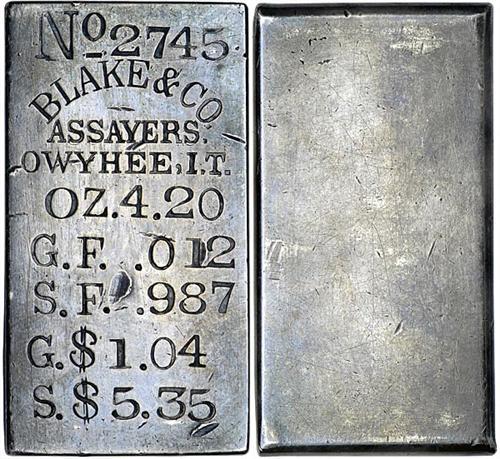
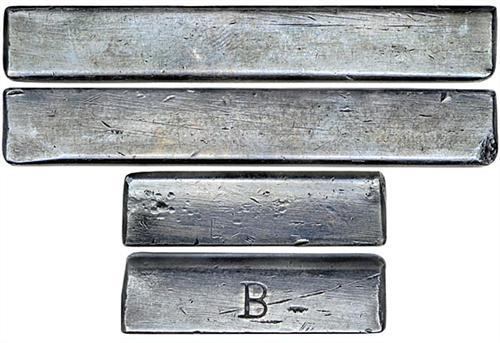
Overall appearance of Extremely Fine. A very handsome ingot, toned in deep silver gray. Surfaces heavily polished before stamping, the layout highly regular, the execution clearly showing a degree of care. This ingot was not made to be casually spent, it has all the look of a special order bar. Perhaps the letter “B” punched into the top side distinguished it from another. There are some unfortunate gouges on the face, one rather large and disfiguring in the center. This ingot can be dated with some precision. The tax law of 1862 was emasculated in December, 1872 and along with it, the requirement of the law of June 30, 1864 that ingots had to be stamped with the OIR seal. Blake’s assaying business in Silver City closed in October, 1873. The bar, consequently, may be dated to the period December, 1872 to October, 1873.
The obvious differences between the layouts of this and the other Owyhee bars in the collection and that seen on the two Unionville bars earlier may perhaps be explainable by a desire to have all commercially important information on a bar presented immediately to sight, eliminating the need to flip the bar around to read each face and all four sides. Note that the layout of the two Unionville bars is nearly the same on each as is that on the four Owyhee bars in the Ford collection, yet the two families are dissimilar. Note also that the Unionville bars bear the town and county name while the Owyhee bars bear only the county name and omit the Silver City town name.
It is also interesting that neither of the Unionville bars signifies anything other than the silver content in their inscriptions, yet the finenesses are low enough to suggest other contents of some significance, part of which must have been gold. The Owyhee bars, on the other hand, carefully indicate their silver and gold contents even though none are obviously commercial ingots. Perhaps Mr. Blake’s operation had become more sophisticated by the time it was moved to Silver City.
- Face: NO.2745 / BLAKE & CO. / ASSAYERS. / OWYHEE, I.T. / OZ.4.20 / G.F. .012 / S.F. .987 / G.$1.04 / S.$5.35.
- Back: blank.
- Top side: B.
- Bottom side: blank.
- Left side: blank.
- Right side: blank.
- Dimensions: 52.5 x 28.2 x 8.4 mm.
- Current weight: 130.8 gms.
From the John J. Ford, Jr. Collection
Provenance: Ex Jim Hosler on November 24, 1966. Mr. Ford’s informational card, Rankow photographs, and correspondence regarding the purchase accompany this lot.
[10/2007] https://auctions.stacksbowers.com/lots/view/3-AV6KV/blake-company-silver-city-owyhee-county-idaho-territory-silver-gold-presentation-assay-ingot-no-2745 ($23,000)
4.55 oz Blake & Company. Owyhee, Idaho Territory no 2745
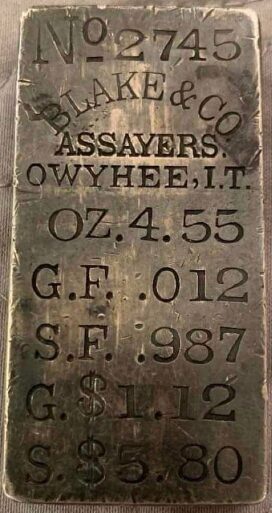
Top To Bottom:
- No 2745
- Blake & Co
- Assayers
- Owyhee, I.T.
- OZ. 4.55
- G.F. .012
- S.F. .987
- G. $1.12
- S. $5.80
A matching pair to the aforementioned Blake & Co presentation ingot from Owyhee, Idaho Territory.
Note this ingot has the same serial as the previous, but one of the edges shows the letter “A” as a pair to the “B” above.
4.10 oz Blake & Company. Silver City, Owyhee County, Idaho Territory. Silver & gold presentation assay ingot no. 1047.
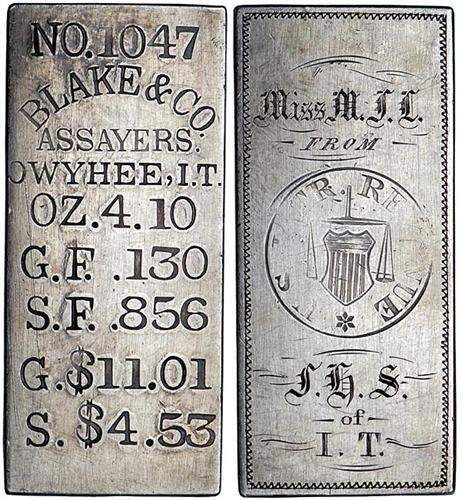

Overall appearance of Extremely Fine. Another handsome ingot, this toned a lighter silver gray. Like the last, surfaces heavily polished before stamping, the face layout highly regular, the back bearing the presentation inscription, the Office of Internal Revenue stamp cleverly serving as a central decorative element. Squared off edges and sharp corners mark this as a carefully made bar. There is one unfortunate production flaw in the top side, otherwise the ingot is remarkably clean.
The tax law of June 30, 1864 requiring OIR stamps on ingots came into effect in September of that year. By December, 1872, it was essentially repealed. This bar, then, may be dated to the period September, 1864 to December, 1872. This is a presentation bar, not a commercial one. The accuracy of commercial assays, especially involving large amounts of bullion, was paramount in the business.
Reliability could best be ascertained by clipping opposing corners of a bar, saving one chip (as they were called at the time) for double checking later and assaying the fineness of the other, whose contents should correspond exactly with the finenesses stamped on the face of the bar. In the case of a bar made for other than commercial purposes, such as presentation pieces and ingots too small to have been worth troubling with, there was no need to put the ingot’s assay to the test. In the case of the former, the sentiment attached to the bar was probably more important to the giver and recipient than the assay of the bar. It seems to the cataloguer that this is why almost all known small assay bars do not have the corner clips found on all the big S.S. Central America gold ingots that were destined for commercial melting pots.
- Face: NO.1047 / BLAKE & CO. / ASSAYERS. / OWYHEE, I.T. / OZ.4.10 / G.F. .130 / S.F. .856 / G.$11.01 / S.$4.53.
- Back: within a decorative border: Miss M.F.C. / FROM / OIR stamp / F.H.S. / of / I.T.
- Top side: blank.
- Bottom side: blank.
- Left side: blank.
- Right side: blank.
- Dimensions: 55.0 x 24.8 x 8.3 mm.
- Current weight: 127.3 gms
From the John J. Ford, Jr. Collection
Provenance: Ex Paul Franklin, obtained from Gimbels coin department through Don Taxay in early October, 1961.
[10/2007] https://auctions.stacksbowers.com/lots/view/3-AV6L1/blake-company-silver-city-owyhee-county-idaho-territory-silver-gold-presentation-assay-ingot-no-1047 ($25,300)
7.13 oz Blake & Company. Silver City, Owyhee County, Idaho Territory. Silver & gold presentation assay ingot no. 1680.
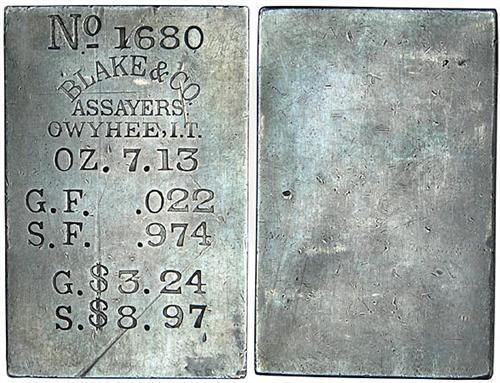
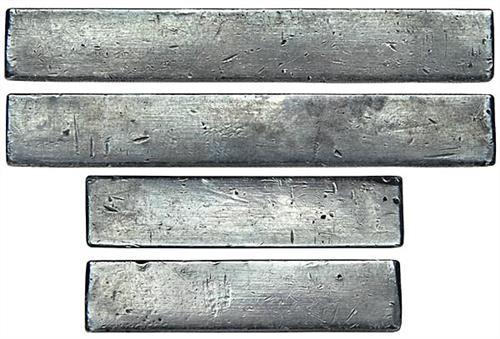
Overall appearance of Extremely Fine. A broad ingot with nice, deep coin silver gray color and some iridescence. Nicely made, with sharp edges, squared off corners, polished surfaces, and Blake’s typical regular layout. The marks on the face that look like scratches were in the surface of the bar before it was stamped and so are as made. This bar may be dated to the period December, 1872 to October, 1873. Like bar no. 2745, this ingot must have been made after December, 1872 when the tax law of 1862 as amended was effectively terminated and before October, 1873 when Blake closed his assaying business in Silver City.
In this respect, it is interesting to note that there are nearly 650 ingot numbers between bar no. 1047 made before December, 1872 and bar no. 1680, made after that date, but over 1,000 ingot numbers between bars no. 1680 and no. 2745 made between December, 1872 and October, 1873. Careful readers will by now have noticed that not only do Blake’s bars show remarkable regularity in their layouts, but also in their shapes and sizes, particularly their thicknesses, which closely range from 8.3 to 9.0 mm. (8.4, 8.3, 9.0, and 8.6 mm., respectively). A similar regularity in thickness may also be observed on the bars made by Conrad Wiegand to be found later in this catalogue. It might be mentioned parenthetically that anyone attempting to counterfeit Blake’s or Wiegand’s bars in the 1950’s would have had to have known that both makers’ genuine bars exhibit a consistent layout and thickness in order to make his copies look like the real thing. And this at a time in our hobby’s history when bars were few and far between in the trade.
- Face: No.1680 / BLAKE & CO. / ASSAYERS / OWYHEE, I.T. / OZ.7.13 / G.F..022 / S.F..974 / G.$3.24 / S.$8.97.
- Back: blank.
- Top side: blank.
- Bottom side: blank.
- Left side: blank.
- Right side: blank.
- Dimensions: 59.8 x 38.7 x 9.0 mm.
- Current weight: 222.5 gms
From the John J. Ford, Jr. Collection
[10/2007] https://auctions.stacksbowers.com/lots/view/3-AV6L7/blake-company-silver-city-owyhee-county-idaho-territory-silver-gold-presentation-assay-ingot-no-1680 ($34,500)
[07/2009] https://auctions.stacksbowers.com/lots/view/3-B2LFU/idaho-territory-owyhee-silver-city-blake-co-assayers-713-ounces-974-fine-silver-022-fine-gold (PASSED)
[06/2011] https://www.icollector.com/ID-Silver-City-Owyhee-County-1872-1873-Blake-Silver-City-Ingot-Territorial_i10679043 ($32,900)
3.10 oz Blake & Co. Owyhee, Idaho Territory. M.J.R. 1867 mixed metal ingot No 928.
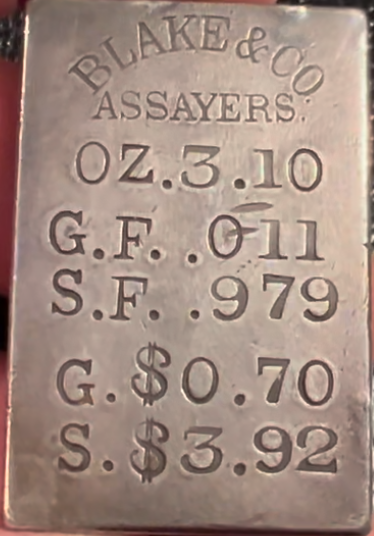
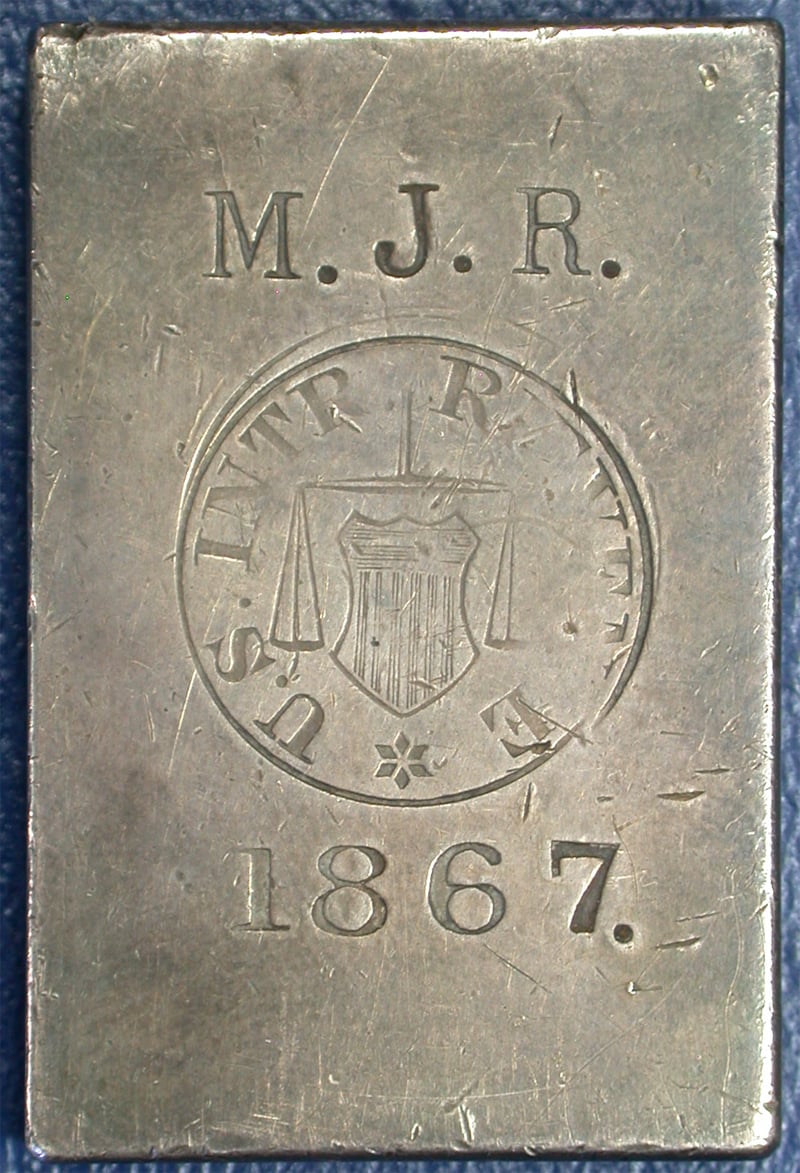
Blake &c Co. Owyhee, Idaho Territory. $4.62 mixed metal ingot. Extremely Fine. Rectangular ingot, No. 928, issued by Blake & Co. Assayers, Owyhee, Idaho Territory, probably circa 1867-70. The stamped weight is 3.10 ounces; the fineness of the gold is .01 1 and the fineness of silver is .979. The respective values of the gold and silver content are stamped on the bottom of the front: gold $0.70 and silver $3.92. The serial number appears on the top edge; “OWY¬ HEE, l.T.” on the bottom edge; and “M.J.R. / 1867” plus the inter¬ nal revenue stamp on the back.
According to Bowers, who cataloged a similar Blake & Co. bar in his 1982 Clifford Sale, “Langley’s Pacific Coast Business Directory, 1867 edition, lists Blake & Co. as assayers in Silver City, Idaho Territory. However, an 1865 listing incorporating the ‘Business Directory of Silver City, in Which the Different Trades and Professions are Classified and Arranged,’ lists bakeries, blacksmiths, dry goods and general merchandise dealers, an engineer, a hair dresser, liquor dealers, livery stables, meat markets, and a surveyor, but no assayers, leading to the conclusion that Blake & Co. was established in Silver City after that date.”
[02/1992] https://archive.org/details/centurycollectio1992supe/page/346/
2.82 oz Blake & Co. Owyhee, Idaho Territory. $4.56 mixed metal ingot.
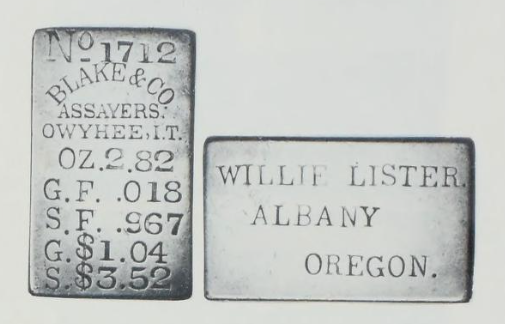
This item was previously featured as lot 222 in the Henry H. Clifford Collection (Bowers & Ruddy, 3/82), where it was described in part as follows: “Rectangular ingot, No. 1712, issued by Blake & Co., Assayers, Owyhee, Idaho Territory, probably circa 1867-1870. The stamped weight is 2.82 ozs., the fineness of the gold is .018, and the fineness of silver is .967. the respective values of the gold and silver content are stamped on the bottom of the front: gold $1.04 and silver $3.52.
“The back of the bar bears the inscription in three lines: WILLIE LISTER / ALBANY / OREGON. This piece is in Very Fine condition and exhibits light wear. Perhaps it was carried as a pocket piece. (A Doctor William Lister is listed as a physician in Albany in the 1867 Langley’s Directory. We cannot find any subsequent citations pertaining to this pioneer physician.”
Rectangular ingot, No. 1712, issued by Blake & Co., Assayers, Owyhee, Idaho Territory, probably circa 1867-1870. The stamped weight is 2.82 ozs., the fineness of the gold is .018, and the fineness of silver is .967. The respective values of the gold and silver content are stamped on the bottom of the front: gold $1.04 and silver $3.52.
The back of the bar bears the inscription in three lines: WILLIE LISTER / ALBANY / OREGON. This piece is in Very Fine condition and exhibits light wear. Perhaps it was carried as a pocket piece. (A Doctor William Lister is listed as a physician residing in Albany in the 1867 Langley’s Directory. We cannot find any subsequent citations pertaining to this pioneer physician.)
Langley’s Pacific Coast Business Directory, 1867 edition, lists Blake & Co. as assayers in Silver City, Idaho Territory. An 1865 listing incorporating the “Business Directory of Silver City, in Which the Different Trades and Professions are Classified and Arranged,” lists bakeries, blacksmiths, dry goods and general merchandise dealers, an engineer, a hair dresser, liquor dealers, livery stables, meat markets, and a surveyor, but no assayers, leading to the conclusion that Blake & Co. was established in Silver City after that date.
The 1871-1873 edition of Langley’s Pacific Coast Business Directory lists Blake & Co. as one of two assayers in Silver City (the other was McDonald & Co.).
A prospectus for the War Eagle Mountain Tunnel Company in the Owyhee District, 1868, mentions Blake & Co. as attestors to the character of the individual who compiled the prospectus.
[03/1982] https://archive.org/details/henryhcliffordco1982bowe/page/n99/
4.22 oz ND (ca. 1863-4). Blake & Co., Assayers, Owyhee, I(daho) T(erritory.) Gold & silver Refined Transport bar, #1390
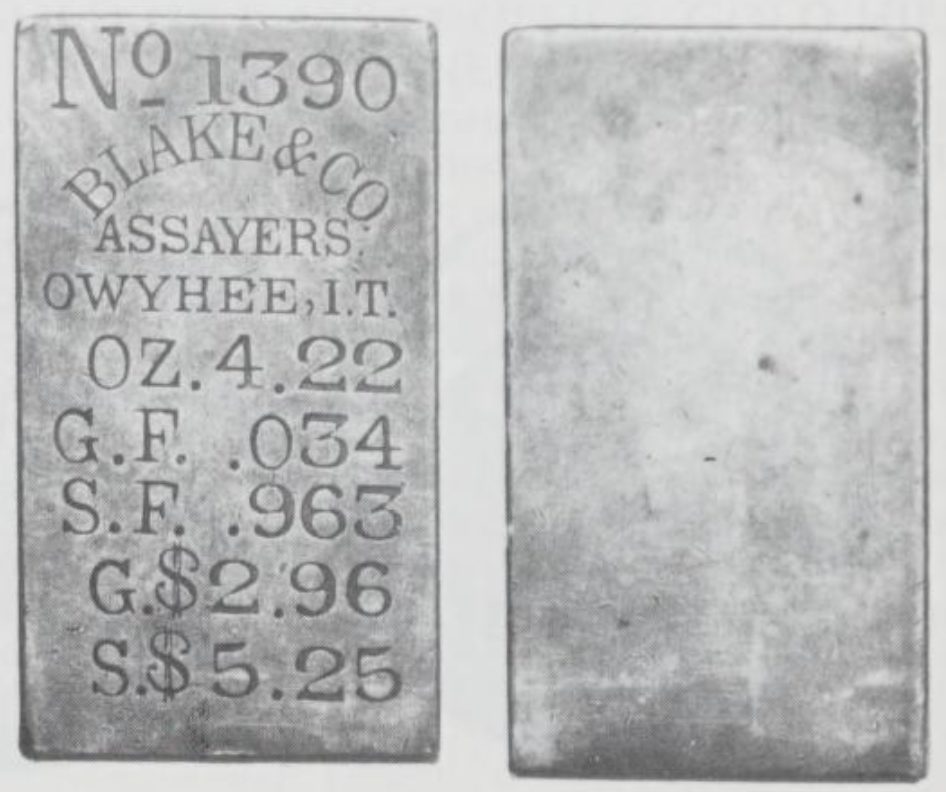
29 x 51 X 8mm., 4.22 Ozs. (2020.35 grains.) Gold Fineness .034, Silver Fineness .963. (G $2.96, S $5.25.) (Photo) ($1, 500-Up)
The Owyhee district, which embraces seivral rivers of that name, covers north central Nevada, southwestern Idaho (where Owyhee County is located), and southeastern Oregon. Gold & silver were discovered here in 1863. Of the two towns named Owyhee, one is just into Nevada, Idaho the one here mentioned is in Idaho, about 20 miles south of Boise. Frank’ Blake operated in Ouyhee and in Idaho City, another major mining center northeast of Boise. He later moved to Prescott, Arizona, and operated as an assayer there. Oioyee itself is a corruption of “Hawaii,” two Hawaiian employees of a fur trader having been murdered in the area at an earlier date. Very rare issue, the mines being short-lived there.
[04/1980] https://nnp.wustl.edu/library/auctionlots?AucCoId=511370&AuctionId=521430
4.10 oz, 1870 Blake & Co. Mixed Metal Presentation Ingot
Blake & Co. Mixed Metal Presentation Ingot. 4.10 Ounces, Owyhee Idaho Territory
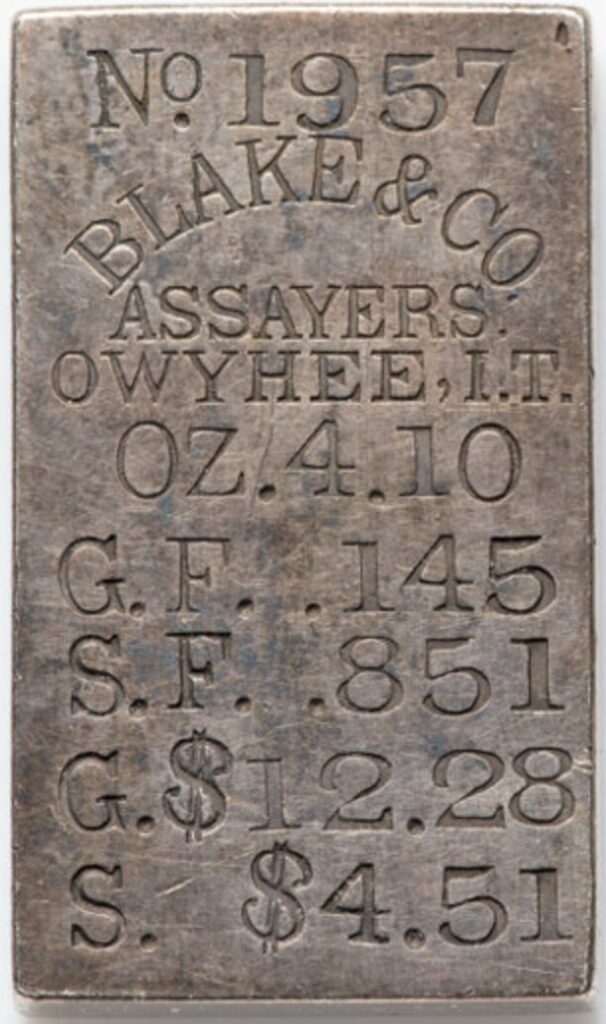
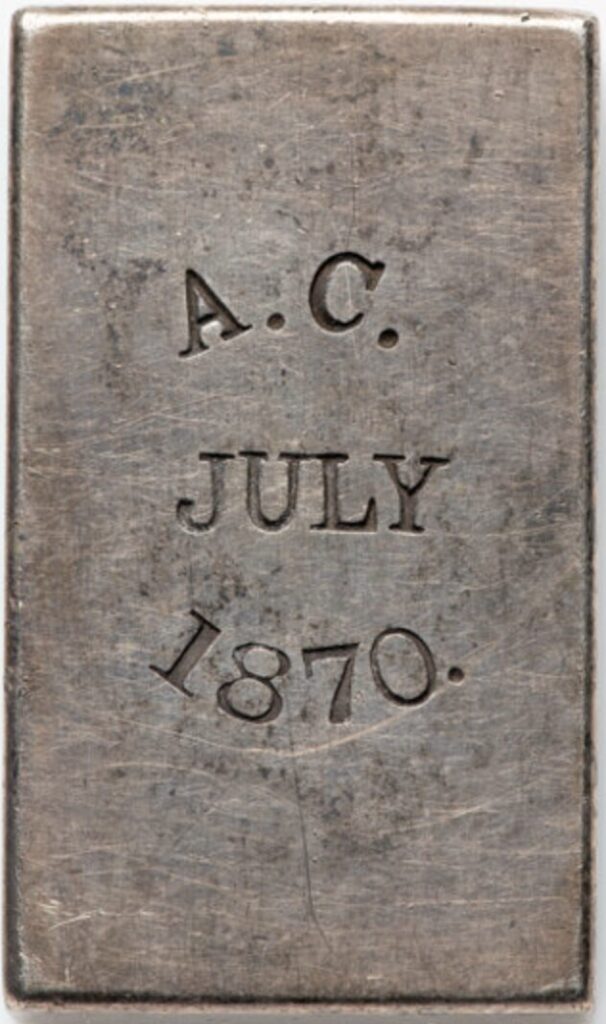
27mm x 46mm x 9mm. This is a carefully made ingot produced in Silver City in Owyhee County of the Idaho Territory, in 1870. All assay information, denoting the gold and silver content of the pour, is laid out vertically on the face of the ingot: No. 1957 / BLAKE & Co. / ASSAYERS / OWYHEE, I.T. / OZ. 4.10 / G.F. .145 / S.F. .851 / G. $12.28 / S. $4.51.
The back side of the ingot reads: A.C. / JULY / 1870. The surfaces are smooth and satiny, with lilac-gray and champagne hues.
[04/2025] https://coins.ha.com/itm/ingots/blake-and-co-mixed-metal-presentation-ingot-410-ounces/a/1382-3620.s ($58,800)
5.38 oz Blake & Company. Silver City, Owyhee County, Idaho Territory. Silver & gold presentation assay ingot no. 945. Dated on the bar January 1, 1868
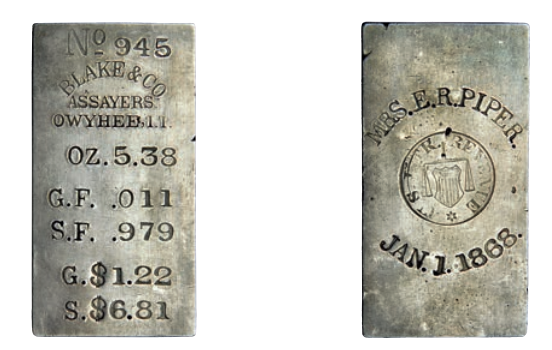
Overall appearance ofExtremely Fine. A very presentable bar, pale silver gray in color. Polished surfaces, sharp edges, squared corners. Typical layout on both face and back for a Blake presentation bar, similar to that seen on bar No. 1047, with equal care taken to the placement of the logotypes, letters, presentation inscription, and the OIR stamp. Several small and not too intrusive edge cuts both sides. A highly important ingot, the ingot date and OIR stamp are essential parts of the argument proving ingots like these are genuine and collectable. Mr. Ford purchased this ingot from the great-granddaughter of the recipient named on the bar. Mrs. Piper’s middle initial, K, was mistaken for an R and was so mis-stamped. Presentation inscriptions were probably written down on paper by the giver and it was up to him to be sure the engraver could read the handwriting and get the spellings right. The seller wrote Mr. Ford saying: “This piece was given my great-grandmother,
Elida Kirkpatrick Piper for the many civic things she had done for the City of Rathdrum, Idaho.” Accompanying the lot are original, yellowed newspaper clippings announcing the death of Mr. J.J. Piper, the husband of the recipient named on this bar. The provenance of this ingot has been condemned as phony but without explaining how a fake pedigree involving a complete nobody makes a genuine bar more valuable than otherwise. The cataloguer has no reason to doubt the authenticity of the pedigree materials that accompany this lot.
- Face: No. 945 / BLAKE & CO. / ASSAYERS / OWYHEE, I.T. / OZ.5.38 / G.F..011 / S.F. .979
- / G.$1.22 / S.$6.81.
- Back: MRS. E.R. PIPER / OIR stamp / JAN.1.1868.
- Top side: blank.
- Bottom side: blank.
- Left side: blank.
- Right side: blank.
- Dimensions: 64.9 x 33.9 x 8.6 mm.
- Current weight: 167.0 gms.
Ex Marie Estinson on January 10, 1966. Mr. Ford’s informational card, Rankow photographs, correspondence from Marie Estinson, 1916 postcard to Estinson’s mother from Piper’s daughter Anita or Abertina, obituaries as noted.
STOLEN
Shortly before this catalogue went to press, this and four other ingots from the Ford Collection were stolen during transit. Since they had already been photographed and described, Stack’s decided to retain their lot descriptions in this catalog in order to preserve their numismatic evidence for future researchers and to aid in their hoped recovery.

